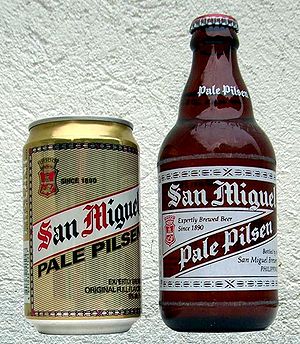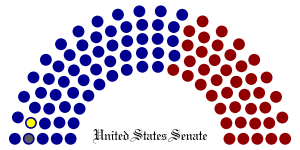 Image via Wikipedia
Image via WikipediaBy Elpidio V. Peria
Last April 12, 2011, the Supreme Court en banc rendered its ruling on one of the most crucial case against the ill-gotten wealth of the Marcoses and their associates dating back from the Martial Law era involving the shares in San Miguel Corporation (SMC) allegedly bought with coconut levy funds exacted from the poor marginal coconut farmers all over the country. This block of shares was purportedly owned by businessman Eduardo “Danding” Cojuangco and is one of many cases filed way back in 1987 by the Presidential Commission on Good Government, as part of its mandate to recover ill-gotten wealth.
In a nutshell, four justices of the Supreme Court ruled that the Government of the Philippines (dubbed as the Republic of the Philippines or Republic, for short, in this case) failed to submit further evidence to prove that the loans from United Coconut Planters Bank (UCPB and the Coconut Industry Investment Fund (CIIF) secured by Eduardo “Danding” Cojuangco to purchase the shares of SMC, were public in character. A dissenting opinion by Justice Conchita Carpio-Morales held the view that it was Dganding who has failed in his burden of showing that such funds were not taken from public funds, while another dissenting opinion, by Justice Brion, takes the view of the majority handing a loss to the Government but urging instead a prosecution of the government lawyers handling the case of Danding, for their mishandling of the case, citing several instances when they could have presented stronger evidence and have taken other steps to bolster their case, but didn't.
To illustrate how significant this SMC-Danding Cojuangco case is, Justice Brion noted that the SMC is a leading food, beverage and packaging company in the country, now with diversified interests and substantial investments in non-related industries like power and other utilities, banking, mining, energy, tollways, infrastructure, and airports with total assets in 2009 amounting to P438.5 billion and income of P57.8 billion – double the amount appropriated in 2010 for health and social welfare, and one-third of that for education. Justice Brion also observed that the SMC generates nearly 4% of the gross national product and pays 6% of the total taxes collected.
According to Justice Brion, the Republic’s Third Amended Complaint, filed in 1995, claimed ownership over the 16,276,545 of SMC shares that were allegedly acquired by Cojuangco in 1983 with the use of coconut levy funds. At the time of acquisition, this Cojuangco block of SMC shares constituted 20% of the total shareholdings of SMC and was purchased for US$49 million. Because of the issuance of new shares, the Cojuangco block’s shareholding was reduced to 17% in 2007 and 15% in 2010. As of December 2010, the remaining 15% shareholding translates to 493,375,183 common shares, and is worth about P84.56 billion or US$1.86 billion. At the current exchange rate, the original acquisition cost of the shares is now equivalent to P2.23 billion, which means that over the past 27 years, the shares have ballooned 38 times its original value.
Farmers' groups all over the land, especially coconut farmers, decried the ruling as it showed how farmers are again being screwed by Government, first during the Marcos era when the coconut levy was exacted from them through the various Marcos Presidential Decrees and now, with this ruling which effectively forfeits their rights to claim a share of this potential windfall, if the disputed SMC shares are sold in the stock market, which, from the point of view of the farmers, belonged to them in the first place.
The core of the case involves involves a simple rule in evidence and is centered on the issue of who now has the burden or the task of showing that one's allegations are correct and are further beyond dispute by the other side and is now supposed to be binding on the court and all the parties?
The majority ruling states that the Republic utterly failed to present evidence to show that the sources of funds used by Eduardo “Danding” Cojuangco are public in character saying that the earlier landmark 2007 ruling by the Supreme Court that such coconut levy funds are “prima facie” public in character does not excuse the government lawyers from presenting further proof that such coconut levy funds were public in character and thus also, ill-gotten by Eduardo “Danding” Cojuangco.
Dissenting Justice Conchita Carpio-Morales holds that the Republic does not have to do anything to prove a “negative averment” (that the coco levy funds are not private) since it behooves on the lawyers of Eduardo “Danding Cojuangco” to show that this is instead private and failing to do this, the presumption that the funds are public had solidified the Republic's claim.
Dissenting Justice Brion holds that the Republic's lawyers already have in their possession, among others, the papers showing the loans made by Eduardo “Danding Cojuangco came from the alleged sources UCPB and CIIF, he was mystified why it was not presented when they had an ample opportunity to do so during the trial of the case at the Sandiganbayan.
If you also note the gaps in time in the prosecution of this case, from 1987 and with constant amendments up until 1999, one will really wonder how zealous the government lawyers were in really wanting to finish this case sooner. Unless they were bribed by the other side, which no sector is making openly, this will remain speculation, unless the current administration takes the suggestion of Justice Brion seriously and will take steps to look for evidence if indeed the government lawyers bungled this case.
How will this case be finally resolved? Senator Joker Arroyo, a key stalwart of the first Aquino administration, is aghast at the public's lack of outrage in this dismissal of the government case, save of course the farmers' groups who are up in arms and are taking steps to push the government to file a motion for reconsideration of the Supreme Court ruling. He is also wondering why there is no statement of anger from within the Office of the President, which to him is just a bunch of amateurs like in a high school student government.
The PCGG said they will take their time and go through the decision and perhaps be guided by the Dissenting Opinion of Justice Carpio-Morales and file the expected motion for reconsideration within the given time.
Come to think of it, the fate of this case does not lie squarely in the hands of the Supreme Court Justices, they have already ruled on the merits. The PCGG in turn, has to make a very good argument in showing that the alleged ineptness of government lawyers do not actually harm the case they are supposed to prosecute. If this sounds like going through the eye of a needle, it surely is and if this will not happen, perhaps the next best thing for the Government is to take up Justice Brion's suggestion and take steps to remedy the alleged bungling of this case by the Republic's own lawyers.
Or perhaps in a gesture of magnanimity when this case has come to finality and the decision at present becomes final or becomes unmodified after the motion for reconsideration, Eduardo “Danding” Cojuangco might take it upon himself to set up a Farmers' Relief Fund, taken from the proceeds of part of the disputed SMC shares, to finally write finis to this case and perhaps shame the Marcoses into doing also the right thing and settling the scores of other cases which to this day, are still pending. Perhaps if these people will start to do these things, then the public may took kindly to finally letting Apo Ferdinand Marcos be buried in the Libingan ng Mga Bayani.
This is wishful thinking, but perhaps, because today is Easter Sunday, this optimism, however misplaced, can be indulged in, even just for a day, but really, things can happen, and what we need to do is await the further developments in this case.
oOo
Comments are welcome! Email me at : pingperia16@yahoo.com
(The author is a Partner at Cartojano Peria & Associates, a full service law firm based in the Philippines)
















![Reblog this post [with Zemanta]](http://img.zemanta.com/reblog_e.png?x-id=0bb67057-7986-4dac-8cc1-323f0148ffac)





![Reblog this post [with Zemanta]](http://img.zemanta.com/reblog_e.png?x-id=3849d6f8-8762-414a-a9f1-d904a8921b8e)




